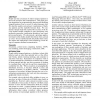Free Online Productivity Tools
i2Speak
i2Symbol
i2OCR
iTex2Img
iWeb2Print
iWeb2Shot
i2Type
iPdf2Split
iPdf2Merge
i2Bopomofo
i2Arabic
i2Style
i2Image
i2PDF
iLatex2Rtf
Sci2ools
UIST
2003
ACM
2003
ACM
Rhythm modeling, visualizations and applications
People use their awareness of others' temporal patterns to plan work activities and communication. This paper presents algorithms for programatically detecting and modeling temporal patterns from a record of online presence data. We describe analytic and end-user visualizations of rhythmic patterns and the tradeoffs between them. We conducted a design study that explored the accuracy of the derived rhythm models compared to user perceptions, user preference among the visualization alternatives, and users' privacy preferences. We also present a prototype application based on the rhythm model that detects when a person is “away” for an extended period and predicts their return. We discuss the implications of this technology on the design of computer-mediated communication. Keywords Awareness, context-aware computing, rhythms, CSCW, user modeling, instant messaging, visualization, CMC.
Related Content
| Added | 05 Jul 2010 |
| Updated | 05 Jul 2010 |
| Type | Conference |
| Year | 2003 |
| Where | UIST |
| Authors | James Begole, John C. Tang, Rosco Hill |
Comments (0)

